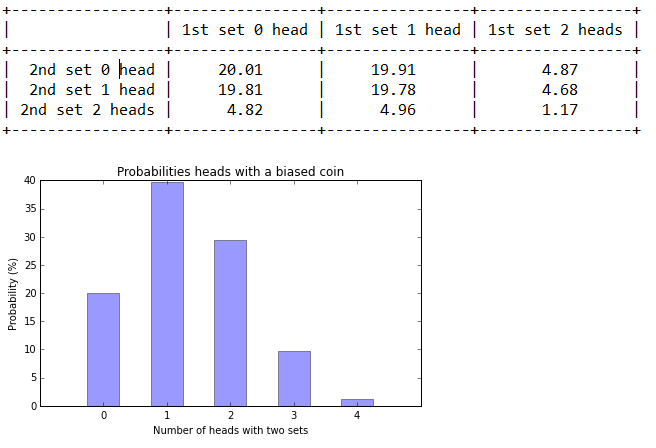(その2)
(文中に出てくるページ参照は 統計学が最強の学問である[実践編]データ分析のための思想と方法 - 西内啓 著 という本のページです。)
コインを2回投げるを1セットとして2セット投げた時の確率
その2では、P61の例のように、「2回投げる」=「1セット」として、2セット投げた場合(つまりコインは4回投げる)の結果を考える。
コインは4回投げられるから、表が出るパターンは
- 表が0回
- 表が1回
- 表が2回
- 表が3回
- 表が4回
の5通り。
コード
from random import randint
from decimal import Decimal
from prettytable import PrettyTable
import numpy as np
def tossBiasedCoin():
""" Returns 0 or 1 with 0 having 2/3 chance """
return randint(0,2) % 2
# Make a 3x3 array
counts = [[0 for j in range(3)] for i in range(3)]
# Toss a coin many times to get counts
sampleCount = 50000
for num in range(sampleCount):
firstSet = [tossBiasedCoin(),tossBiasedCoin()]
secondSet = [tossBiasedCoin(),tossBiasedCoin()]
counts[sum(secondSet)][sum(firstSet)] += 1
# Conert all counts to perentage
TWOPLACES = Decimal(10) ** -2
for i in range(3):
for j in range(3):
value = counts[i][j]
counts[i][j] = (100 * Decimal(counts[i][j])/Decimal(sampleCount)).quantize(TWOPLACES)
print("Converted the value {} to percentage {}".format(value, counts[i][j]))
# Make summaries of number of heads.
keys = np.arange(5)
values = [counts[0][0], # 0
counts[0][1]+counts[1][0], # 1
counts[0][2]+counts[2][0]+counts[1][1],
counts[1][2]+counts[2][1],
counts[2][2]]
# Add row descriptions
counts[0].insert(0, '2nd set 0 head')
counts[1].insert(0, '2nd set 1 head')
counts[2].insert(0, '2nd set 2 heads')
# Create table with column descriptions, add rows, then show it.
table = PrettyTable(["", "1st set 0 head", "1st set 1 head", "1st set 2 heads"])
table.padding_width = 1
table.add_row(counts[0])
table.add_row(counts[1])
table.add_row(counts[2])
print table
# Draw a bar chart
import matplotlib.pyplot as plt
fig, ax = plt.subplots()
rects = plt.bar(keys,
values,
0.5,
alpha=0.4,
align="center",
color='b')
plt.xlabel('Number of heads with two sets')
plt.ylabel('Probability (%)')
plt.title('Probabilities heads with a biased coin')
plt.xticks(keys, np.arange(5))
plt.tight_layout()
plt.show()
基本的には前回とほとんど同じプログラム構造。
結果を格納する変数が増えた
図1-19と同じにするために3x3の list を作る。
# Make a 3x3 array
counts = [[0 for j in range(3)] for i in range(3)]
コインを2セット(1セット=2回)投げる
50万回ループさせ、毎回合計4回コインを投げる。
# Toss a coin many times to get counts
sampleCount = 50000
for num in range(sampleCount):
firstSet = [tossBiasedCoin(),tossBiasedCoin()]
secondSet = [tossBiasedCoin(),tossBiasedCoin()]
counts[sum(secondSet)][sum(firstSet)] += 1
棒グラフのデータの準備
ちょっと面倒になってきた。「表が2回(枚)」でるパターンは、2セットの内、
1セット目が2枚、2セット目が0枚
1セット目が0枚、2セット目が2枚
1セット目が1枚、2セット目が1枚
の3通りあるから、それをすべて足す。
# Make summaries of number of heads.
keys = np.arange(5)
values = [counts[0][0], # 0
counts[0][1]+counts[1][0], # 1
counts[0][2]+counts[2][0]+counts[1][1],
counts[1][2]+counts[2][1],
counts[2][2]]
表のデータの準備
2x2構造から3x3構造に変えるために、3行目を加える。
# Add row descriptions
counts[0].insert(0, '2nd set 0 head')
counts[1].insert(0, '2nd set 1 head')
counts[2].insert(0, '2nd set 2 heads')
表と棒グラフを作る
基本的には増えた分に対応して変更を加えている。
# Create table with column descriptions, add rows, then show it.
table = PrettyTable(["", "1st set 0 head", "1st set 1 head", "1st set 2 heads"])
table.padding_width = 1
table.add_row(counts[0])
table.add_row(counts[1])
table.add_row(counts[2])
print table
# Draw a bar chart
import matplotlib.pyplot as plt
fig, ax = plt.subplots()
rects = plt.bar(keys,
values,
0.5,
alpha=0.4,
align="center",
color='b')
plt.xlabel('Number of heads with two sets')
plt.ylabel('Probability (%)')
plt.title('Probabilities heads with a biased coin')
plt.xticks(keys, np.arange(5))
plt.tight_layout()
plt.show()
結果
なんだか「標準偏差」のグラフっぽく見えて来たぞ!っというのがこの本の、この章がデモンストレーションしようとしているそもそもの内容。
さらに「表が1枚」になる確率が一番高いのが分かる。これは「4回投げて表が出る確率(1/3)」はすなわち「4 x 1/3」= 1.333。つまり「4枚投げりゃぁだいたい表が1枚でるぞ」ということを表している。
(その3)につづく。
